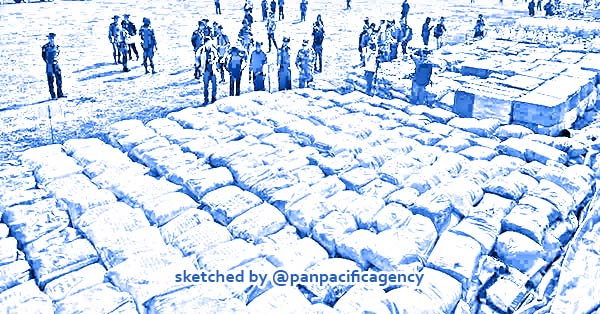Drug production spike in S-E Asia calls for new approach to end trade: UN

Foreign military attaches check drugs in a football ground where seized drugs, vehicles, laboratory accessories and precursor chemicals are being displayed to invited military attaches and journalists in Kawangkha on 6 March, 2020. (AFP Photo) Sketched by the Pan Pacific Agency.
WASHINGTON D.C., Jun 25, 2021, ST. Close to 1.2 tonnes of heroin and methamphetamine were discovered by the Thai authorities last Friday (June 18), The Straits Times reported.
The drugs had been hidden in fruit containers in a mangrove forest in the southern province of Satun, to be picked up during high tide and transported to Malaysia.
The find made evident that instead of abating, the tsunami of methamphetamines flooding the region is growing.
A report from the United Nations Office on Drugs and Crime (UNODC) that was released on June 10 confirms that roughly 170 tonnes of methamphetamine were seized in the region last year – a 19 per cent increase over the 142 tonnes seized in 2019.
Cambodia, Laos, Myanmar, Thailand and Vietnam accounted for 71 per cent of total seizures.
But seizures are the tip of the proverbial iceberg; all they make clear is that despite tighter border controls on account of the Covid-19 pandemic, transnational organised crime groups thrived in 2020.
Organised criminal groups are highly mobile and constantly look for areas where they can make methamphetamines, said Mr Inshik Sim, research officer for illicit drugs at the UNODC in Bangkok.
“We should not underestimate organised crime groups,” Mr Sim told The Straits Times’ Asian Insider, citing their ability to adapt.
South Asia
Trafficking from Myanmar to South Asia is an additional and growing concern.
“Over a decade, the methamphetamine market (in South-east Asia) has grown every year,” Mr Sim said.
Bangladesh shows a similar pattern, he said. “About a decade ago, only 1.3 million meth tablets were seized in Bangladesh. But in 2020, they seized over 40 million.
“The most concerning thing here is that there is potential for further growth in Bangladesh and India when you look at the population. Bangladesh has 163 million people and India has about 1.4 billion people. So it is a really big market that can attract organised crime groups to constantly target or increasingly target these two countries.”